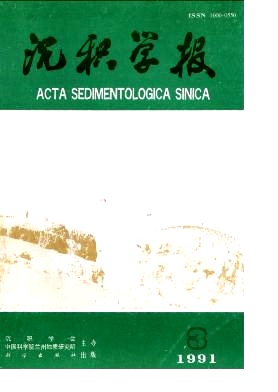The Discovery and Environmental Significance of Vivianite Nodule in Xingyun Lake, Yunnan
- Received Date: 1989-04-11
- Publish Date: 1991-09-10
Abstract: Xingyun Lake is a faulted trough lake which measures 10.5 by 3.8 km. The formation of vivianite nodule in which has been systematically researched by field observation and the using of the techniques of x-ray diffraction and x-ray photograph, infrared spectrogram, stable isotope analysis, chemical composition analysis and electron microprobe analysis, etc. The vivianite which is first discovered in Xingyun Lake has been determined and its physical properties, chemical composition, mineralogical parameters have been described in detail. A typical x-ray peaks (7.8899? 6.691 ?, 4.896?, 4.062?, 2.917?, 2.702?,) and infrared spectrograms (3137-1cm. 1600-1cm. 1090-1cm. 940-1cm. 540-1cm. and 470-1cm.), x-ray photograph data (a= 10.096A, b= 13.50?, c = 4.70?, 0= 104°34 ' ) of vivianite have been supplied. The origion model of vivianite in Xingyun Lake has been put forward based on the discussion of the sources of phosphorus and ferric matter and the formation of reducing environment. The ferric matter was carried by river and the phosphorus matter by animal, vegetation and bacterial reduction, and then deposit in low enery areas. The organic matter and organisms are buried by sediments, and pore water is enclosed in it. The organic matter is decomposed and carbon dioxide is produced by the bacteria action and fermentation. Under the reducing environment, ferrous (Fe3+) is reducd to ferric (Fe:2+). Vivianite is supersaturated and precipitated from sediments as the contents of ferric and phosphated ion of pore water increase. The chemical reaction equation is as folio ws. 3Fe2++2HPO42-+2OH-1+6H-2O=Fe3(PO4)2 · 8H2O (vivianite) The condition of the formation of vivianite itself, diagenesis of sediments, trace elements, stable isotopes, rock properties and sedimentary structures as well as clay mineral assemblages of welling core burying in vivianite have been studied. It can be deduced that the vivianite nodules may stand for the primary edimentary environment, i. e., a sedimentary symbol of inland fresh lake ,and it is only discovered in sediments of fresh shallow lake and lake bay. That is ,it formed in a low energy environment of fresh shallow lake or lake bay.
| Citation: | Zhao Yongsheng, Zhao Xiafei. The Discovery and Environmental Significance of Vivianite Nodule in Xingyun Lake, Yunnan[J]. Acta Sedimentologica Sinica, 1991, 9(3): 116-122. |






 DownLoad:
DownLoad: